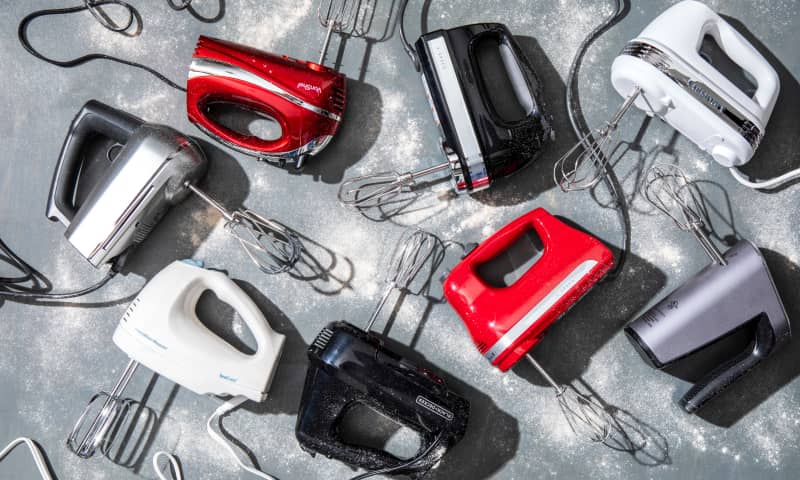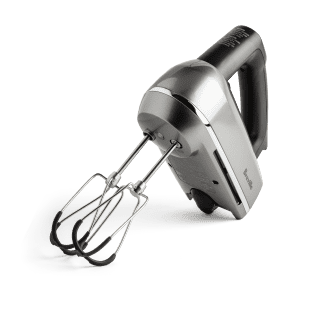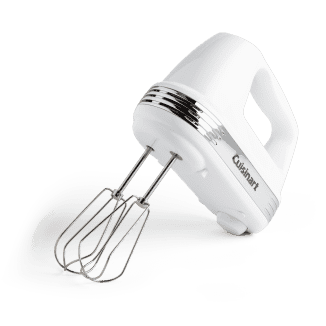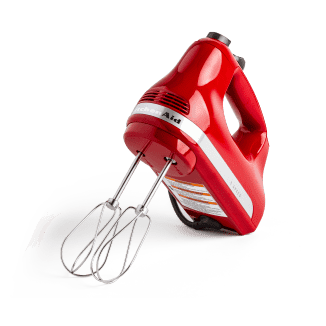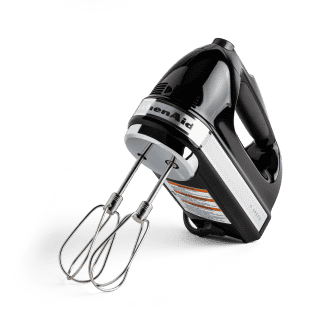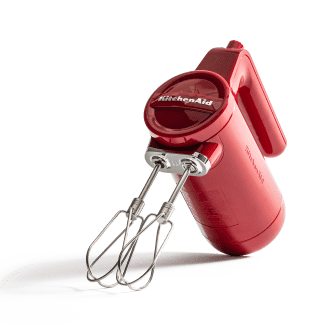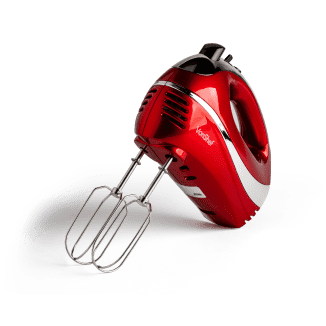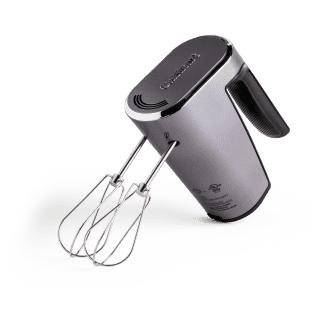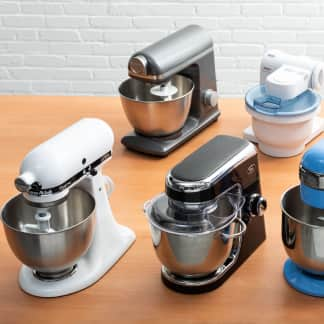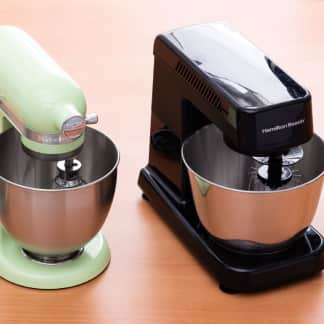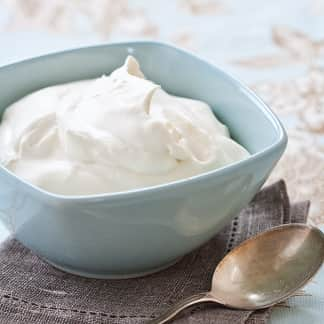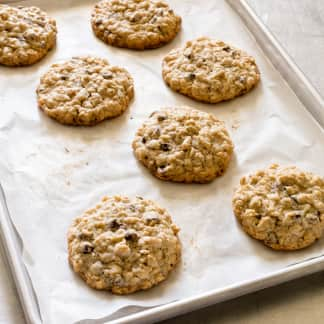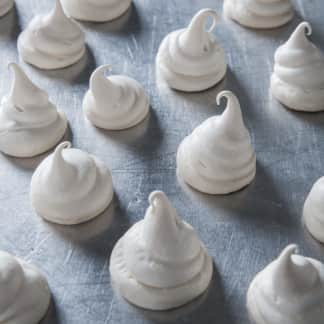Hand mixers are a useful addition to any baker's kitchen. We often use them to whip cream, cream together butter and sugar for baked goods, and beat egg whites for meringue. They also take up less storage space than a stand mixer and are much easier to maneuver. We were looking for a mixer that was powerful and easy to use and had a range of speed settings, and we found all that and more in our new winner, the Breville Handy Mix Scraper. We also love our Best Buy, the Cuisinart Power Advantage Plus 9 Speed Hand Mixer with Storage Case, which offers similar mixing prowess without the bells and whistles of our winner.

Hand mixers strike a happy medium between combining ingredients by hand and hauling out a heavy stand mixer every time you want to mix. We use them in the test kitchen for whipping cream; beating egg whites into meringue; and combining ingredients for single batches of cookies, cakes, or pies. We think a hand mixer is an especially good option for people looking to get into baking without making a huge investment, people who don’t have much storage space, and people with arthritis or certain disabilities that prevent them from lifting a larger mixer. While hand mixers make many baking projects much easier, we’ve found that they are not powerful enough to mix most bread or pizza doughs, despite some manufacturers’ claims. Still, we think they can be an important and convenient addition to your kitchen arsenal.

All the mixers in our lineup came with a pair of standard beaters, and some included whisk attachments and dough hooks as well. We tested all the attachments where applicable.
All hand mixers include two standard beater attachments and often one or two whisk attachments and a pair of spiral-shaped dough hooks as well. After first testing all the models with their beaters, we tested the models equipped with whisk attachments by preparing an additional batch of meringue. Finally, we outfitted our top two models with their dough hooks and mixed Bagel Bread (more on this below).
What to Look For
- Wide Beater Heads: Beater heads with wider diameters (at least 2 inches across) mixed most efficiently, since they were able to move a larger volume of ingredients at once. They also trapped less cookie dough, since chunkier ingredients such as chocolate chips and rolled oats were able to pass through the broader gaps between the tines more easily.

Wider beaters covered more ground and mixed more efficiently. Narrower beaters took longer to combine ingredients and often got clogged because there wasn't enough space for ingredients to pass through.
- Simple, Intuitive Controls: The mixers came with analog or digital controls (a couple mixers had both). We liked both styles, as long as the controls were simple: a single wheel to scroll or two buttons for adjusting speed up and down.
- Wide Range of Speed Settings: Every mixer supposedly offered a range of slow and fast speed settings (from five to nine). But the slowest settings on some mixers were much too fast. The best mixers offered a true range of speeds, starting at about 350 rpm and maxing out at 1,300 rpm. Slower settings allowed us to combine powdery and liquid ingredients without flinging them everywhere; faster settings let us whip up stiff meringue and crank out dense cookie dough in no time.

It wasn't the only determining factor in a good mixer, but there was a clear trend: We preferred mixers with a wide range of speeds, from slow settings to keep messy ingredients contained, all the way up to fast settings to power through tough mixes.
- Powerful Motor: Our favorite mixers were powerful enough to muscle through stiff cookie dough filled with chocolate chips and rolled oats without getting stuck or slowing down.
- Ejection Triggers: Our favorite models have triggers under their handles that eject the beaters with a simple pull, allowing us to remove the beaters without too much effort or mess.

We preferred models with trigger-style eject mechanisms that made it easy to remove the beaters cleanly.
- Cord Control: Mixers that included built-in plastic or elastic wraps to corral and organize cords were our favorites, since they were easier to store.
Nice to Have
- Storage Cases: Models with storage cases that attached to the mixers’ undersides made organizing cords and attachments a breeze and allowed for easy and convenient storage in a cabinet or deep drawer.

We appreciated models that came with storage cases, which kept attachments and cords organized and made for easy storage in a cabinet.
- Rubber-Tipped Beaters: Beaters with rubber-coated heads didn’t clang around in bowls as we mixed, reducing the overall racket and making for a more pleasant baking experience.
- Timers and Pause Buttons: Our favorite mixer has a timer on its small display screen that allows you to see how long you’ve been mixing. It also sports a pause button that halts both the mixer and the timer, which was great when we stopped to check the consistency of meringue or to scrape down the bowl.
What to Avoid
- Complicated Controls: Trying to operate a mixer with too many confusing switches and buttons can be frustrating. A couple of the mixers we tested combined analog and digital controls unsuccessfully; we never knew whether to flick a switch or press one of several buttons. We had to press the buttons on one finicky model multiple times to activate it, which slowed us down.
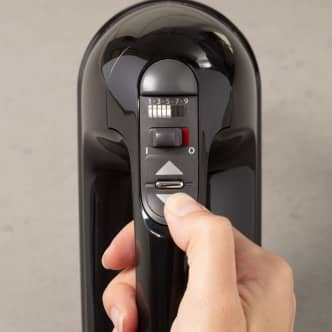
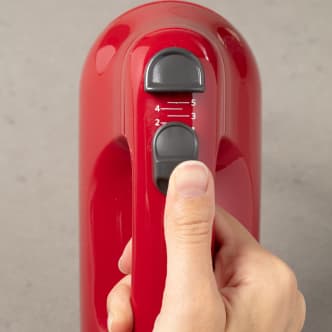
Some mixers had controls that were too complicated, leading us to accidentally turn them off in the middle of mixing throughout the testing process. We preferred simpler, more straightforward controls that were easy to operate.
- Narrow Beater Heads and Beaters with Center Posts: Mixers with narrow beaters were less efficient because they mixed a smaller volume of ingredients at once, slowing things down considerably. They also trapped chunkier ingredients, which couldn’t escape through the narrow gaps in their tines. Beaters with center posts also got clogged more often, since ingredients couldn’t freely pass through the beater heads.
- Overzealous Mixers: A few mixers’ slowest settings were too fast for even gentle mixing. The result? Heavy cream all over the countertop.
Other Considerations
- Cordless Mixers: Cordless hand mixers are newly popular. We’ve tested two and liked that both models freed us from being anchored to an outlet as we mixed. Still, neither model performed well enough for us to fully recommend them, either because we disliked their controls or found them to be too weak to quickly and thoroughly incorporate ingredients. For now, we suggest sticking to hand mixers with cords.
- Make Lightly Sweetened Whipped Cream using the beater attachments, starting on medium-low speed and then increasing to high speed
- Make Chocolate Chip Oatmeal Cookies using the beater attachments, starting on medium speed to cream the butter and sugar, adding the dry ingredients, then gradually increasing from low to high speed to mix the dry ingredients
- Make Classic Meringue Cookies using the beater attachments first and then the whisk attachments (when applicable), mixing on high speed
- Measure the speeds of the lowest and highest settings using a tachometer
- Insert and eject the beaters 100 times
- Wash the beaters by hand and wipe down the mixer bodies throughout testing and then 10 additional times
- Winner and Best Buy only: Make Bagel Bread with the dough hook attachments, using medium speed to knead the dough
